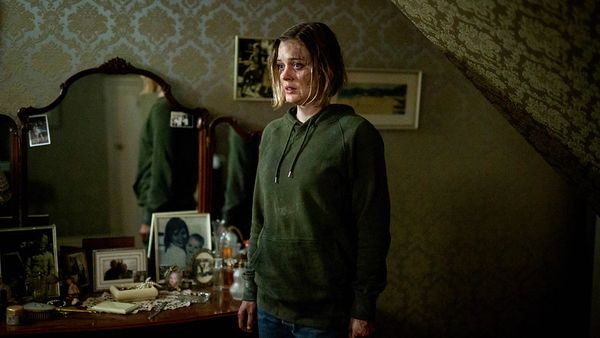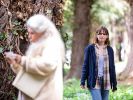Eye For Film >> Movies >> Relic (2020) Film Review
Relic
Reviewed by: Jennie Kermode

There's one monster that we see surprisingly little of in horror films. It's the one that's coming for all of us and that, sooner or later, always wins.
Death is a difficult concept to address in cinema, at least in the absence of fantasy or sentimentality. It's too abrupt, too hard to comprehend emotionally. It doesn't fit the narrative. Dementia, however, draws the process out, giving a brave filmmaker something to get to grips with. The slow disappearance of what distinguishes us as living individuals. The slow disintegration of the body, too, as each particle of it makes its inevitable journey back into something inanimate, ready to merge with the great senseless, meaningless mass of matter that makes up most of our world.

Edna (Robyn Nevin) has been getting a bit confused, on and off, for a while. When her daughter Kay (Emily Mortimer) hears from one of her neighbours that she's gone missing, she and her daughter Sam (Bella Heathcote) rush to the rescue, exploring the rambling house where Kay grew up, alerting local police and organising a search of the surrounding woodland. It's a relief to all involved when Edna returns safe and sound, but she can't explain where she's been and her behaviour has become extremely erratic. As the two younger women argue over the best way to care for her going forwards, she begins to express worries about something following her or trying to get into her house, and her own behaviour shifts from ditzy to haunted to unpredictably, frighteningly violent.
Director Natalie Erika James, still only in her twenties, draws viewers into her astonishing debut feature by externalising the horrors of a disease that will be all too familiar to many and employing surrealist techniques that have the effect of making us as disorientated as Edna herself. The carefully decorated, cluttered house feels familiar and safe at first but soon begins to reveal its strangeness: little mnemonics and systems that Edna has used to cope, complemented by ritualistic behaviour; then all the odd lost things that people out down and forget. It was once a warm family home but now it's too large for Edna, and it comes to seem larger and larger as the film goes on, its geometry ever more bizarre. Material objects don't behave quite as they should. Kay, indulging her mother by checking under the bed for intruders, thinks she sees something out of the corner of her eye.
Edna is clearly in the final stages of her life. When wandering in the woods she seems to be operating according to a new logic or a very old one, as if returning to a wild state, as if she had never been tamed and taught to behave like a human. Kay, middle aged, feels that she has to be the sensible one, coming up with practical solutions yet hesitating to make them happen, refusing to believe everything her eyes reveal to her. Sam, who finds time to argue with her over other age-related issues around careers and responsibility and settling down, is young enough not to have erected the emotional barriers that afford Kay some protection. Her volatility reflects her grandmother's. She's horrified by what she sees as her mother's callousness, but may be taking on too great a risk. And all of them, in the end, are on the same mortal path.
With relatively simple though often distressing visual effects, Relic (the title might refer to the house, to Edna or to a gene variant, among other things) delivers some of the most disturbing, close to the bone horror to grace the screen for years, in a film that is also tender and humane. The aching loss at its core reflects more than one person's disintegration. James speaks to deep terrors of the sort we can avoid only by eschewing realism; horrors that do not recede when the screen goes black.
Reviewed on: 07 Jul 2020
















